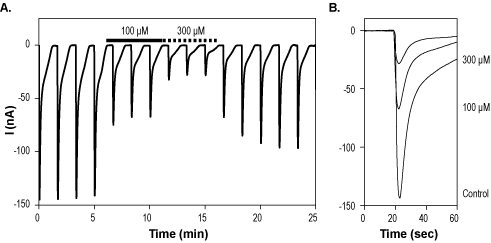Overview
- Czuczwar, S.J. et al. (1998) Eur. J. Pharmacol. 359, 103.
 Alomone Labs Talampanel inhibits GluA1 channels expressed in Xenopus oocytes.A. Time course of 100 and 300 μM Talampanel (#T-185) reversible inhibitory action on glutamate elicited currents (100 μM, delivered every 100 seconds, holding potential -80 mV). B. Superimposed current traces of control and inhibited current as indicated (taken from the experiment in A).
Alomone Labs Talampanel inhibits GluA1 channels expressed in Xenopus oocytes.A. Time course of 100 and 300 μM Talampanel (#T-185) reversible inhibitory action on glutamate elicited currents (100 μM, delivered every 100 seconds, holding potential -80 mV). B. Superimposed current traces of control and inhibited current as indicated (taken from the experiment in A).
- Howes, J.F. et al. (2007) Neurotherapeutics 4, 126.
Glutamate is the main excitatory neurotransmitter in the CNS and is also involved in a variety of pathological conditions including epilepsy. Glutamate binds to a number of different receptors such as AMPA, Kainate and NMDA that relay its excitatory activity.
Talampanel (Ampanel, Kinampa, LY 300164, GYKI 53773) is a potent non-competitive AMPA and Kainate antagonist. It has an effective concentration of 10-300 µM. Talampanel was examined in several animal models; sub protective doses of Talampanel potentiate the anticonvulsant effect of other anticonvulsant drugs such as valproate and phenytoin. In addition, it shows neuroprotective properties by enabling the survival of hippocampal neurons after carotid artery occlusion. Repeated administrations of Talampanel in rats undergoing middle cerebral artery occlusion (MCAO) caused an improvement in rotarod and beam walking and reduced the number of MCAO induced rotations compared to rats receiving placebo treatment. In humans, Talampanel is administered orally and is well absorbed. It reaches peak concentration after 2 hours with a half-life of 4 hours. In humans, administering valproate with talampanel does not affect talampanel and N-acetyl-talampanel kinetics. Talampanel is used for the treatment of epilepsy and is well tolerated in adults with refractory complex partial seizures. Its main adverse effects are dizziness and ataxia.
Talampanel (#T-185) is a highly pure, synthetic, and biologically active compound.

